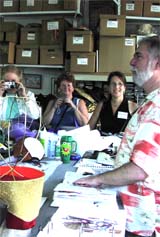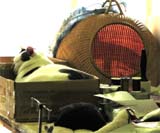 |
 |
 |
|
News & Notices
News From:
Commissions
Conference & Stage Expo
For the Record
|
Costume Symposium
Takes Manhattan in Stride The 2005 Costume Symposium was a sell out, drawing an enthusiastic group of participants this August to the streets and shops of New York City. It was a quintessential New York summer, hot and steamy, but the host site of New York University's Tisch School of the Arts provided a wonderful venue allowing all to escape the heat and focus on packing in as much as possible to learn about the city and its resources. The opening session featured Tony award-winning costume designer Marty Pakledinaz in a very candid discussion of what it is like to work in the industry and be based in the city. He provided insights into the daily realities as well as the evolution of his career from his education to the present. We were fortunate to also view a wide selection of his sketches, including those from his Tony-winning Thoroughly Modern Millie. Mr. Pakledinaz's stories and experiences provided the perfect introduction to the sessions and tours that followed during the three day symposium. The successive sessions dealing with Re-mounting Productions and Pricing Sketches illustrated the diverse range of possibilities afforded in major shops and theatres. Panelists for the re-mounting session spoke about the challenges presented when a show is revived. We heard from the perspectives of ballet, opera, Broadway, and tours focusing on some of the differences and similarities encountered, as well as maintaining the integrity of the original design. Panel chair and milliner Arthur Levine assembled shop heads to lead a discussion on the finer points of pricing sketches for several different markets including Broadway and industrial perspectives. Symposium participants supplied a wide array of sketches to spark discussions of all aspects that must be considered when a shop is bidding on a costume. The symposium also included sessions on how to use the city's resources. The panel on Shopping and Researching featured panelists who make their living shopping and finding the perfect fabric or accessory. Symposium participants were able to grill the pros on the best places to find a wide variety of specific items. A panel on using the city for training students had a variety of panelists discussing how their particular institution took advantage of the city to set up internships in shops, shop for shows, obtain grants for study, and creating classroom projects that use the city in unique ways. The last panel session dealt with the specialized areas of props and crafts, and the shifting resources and shopping districts of the city in the past few years. How the Internet has revolutionized procuring props and materials was also a hot topic. In addition to the selection of panels and workshops held at NYU, symposium participants had a variety of tours to choose from that literally put them on the streets and subways of the city. By using feet and wheels, participants navigated the neighborhoods and districts to see firsthand what is available in the stores, what can be produced in the shops, and what research opportunities are available. Tour stops included costume shops such as Parsons-Mears, Tricorne Costumes, Broadway Wigs, Carelli Costumes, Isquierdo Costume Crafts, Arnold Levine Crafts, and Euroco. There were also backstage tours of the Metropolitan Opera and The Lion King. The shops illustrated the wide range of costume production services available in the city. Participants saw more than stores and shops. They went behind the scenes at several research facilities including the Fashion Institute of Technology, the Metropolitan Museum's Costume Institute, and the New York Public Library's Picture Collection. The costume collections provide a stunning array of historic clothing pieces and textile samples available to researchers and designers to view and study. The methodology of conservation and how exhibits are created also were well presented. Concluding the series of panels were two workshops demonstrating some of the craft techniques developed in the city. Janet Bloor of Euroco presented silicone appliqué. Through her demos, she gave participants the basics of how to create some of the effects such as lumpy lizard skin, raised rings, and "fake" beading. Many of her fabric treatments were the result of experimenting with different fabrics and application of the silicone, and her parting words encouraged participants to "play around with the medium and see what happens." The final workshop was presented by milliner Scott Coppock. He demonstrated ways to create hat blocks for unique shapes as well as discussing many of the past projects he had been involved in, such as the current Broadway production of Wicked. Overall, it was an action-packed three days that went by in a blur. The experiences allowed participants to get a crash course on the city so on future visits, they have a good base of knowledge from which to work |
 A visit to Arnold Levine Crafts was just one stop on one tour for those taking part in the 2005 Costume Symposium held this August in New York City.

Seminars and visual presentations, above top, were mixed with visits to Manhattan shops, including Euroco where the cat, immediately above, slept peacefully through the experience.
Photos/Kristina Tollefson
|